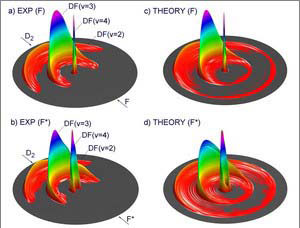| Posted: September 3, 2007 |
A case where Born-Oppenheimer Approximation breaks down |
|
(Nanowerk) The Born-Oppenheimer (BO) Approximation is ubiquitous in molecular physics, quantum chemistry and quantum chemistry. However, Chinese Academy of Sciences (CAS) researchers recently observed a breakdown of the Approximation in the reaction of fluorine with deuterium atoms. The result has been published in the August 24 issue of Science.
|
|
Proposed in 1927 by Max Born and Julius R. Oppenheimer, the BO approximation suggests that since nuclei are so much more massive than electrons, they must move much more slowly. Hence the motions of the two can be separated (the nuclei can be considered as stationary points around which the electrons move). It is still indispensable in quantum chemistry and used for the establishment of a molecular dynamic model for a simple chemical or physical system.
|
 |
Differential scattering images of reactions between excited and ground-state fluorine with D2. (Image: CAS)
|
|
According to the approximation, the chemical reaction between the fluorine atom in its excited state (F*) and deuterium (D2) could not occur. However, in a recent experiment conducted by a research group led by YANG Xueming with the State Key Laboratory for Molecular Reaction Dynamics attached to the CAS Dalian Institute of Chemical Physics observed the reaction by using a state-of-the-art facility they have developed.
|
|
At the lowest collision energy, the scientists found that F* is 1.6 times more reactive than F, although reaction of F* is forbidden within the BO approximation. This fact indicates the BO approximation cannot be applicable to this reaction. Before long, this important process in non-adiabatic dynamics has been depicted by researchers from the University of Maryland after full quantum scattering computation by using precise potential energy face with multi-coupling.
|
|
Because non-adiabatic dynamics is a hot topic in molecular reactive dynamics and a cutting-edge area of theoretical chemistry nowadays, the discovery achieved by the Dalian scientists is considered an academic breakthrough with an exceptional significance as it is conducive to making clear the reactive mechanism which governs the system of this kind of chemical laser devices. In addition, the breakthrough signifies Chinese research in this aspect has reached the disciplinary forefront so far accomplished by the international community.
|

